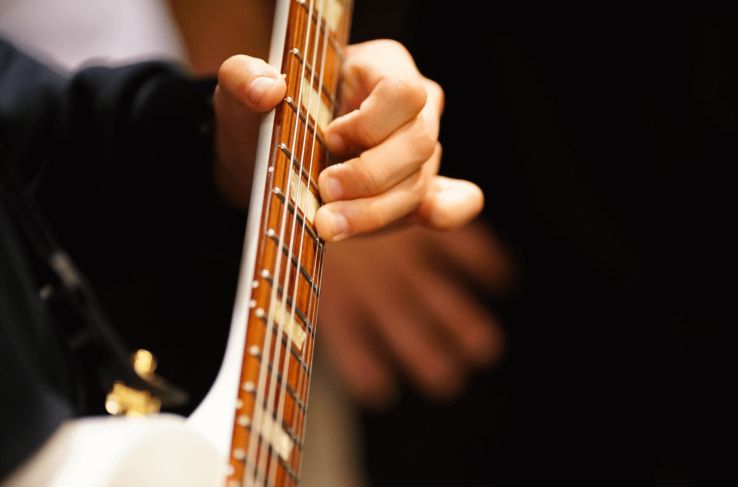How To Master Advanced Guitar String Bends
by Tom Hess
Emotion To Any Guitar Lick

EMAIL TO GET ACCESS
By submitting your info, you agree to send it to Tom Hess Music Corporation who will process and use it according to their privacy policy.
Think you can play guitar string bends well?
Let’s find out:
How many 2.5 step guitar string bends did you use in your last solo?
When was the last time you played a sliding chain of guitar string bends?
How often do you play half-ghosted guitar string bends?
Ok, I don't expect you to know these names, but...
...these techniques are advanced variations of basic guitar string bends.
Emotion To Any Guitar Lick

EMAIL TO GET ACCESS
By submitting your info, you agree to send it to Tom Hess Music Corporation who will process and use it according to their privacy policy.
Good news is:
Anyone can learn to play them – including you.
And when you do - every lick you play will drip with heart-piercing emotion.
Check out this advanced guitar string bends demonstration and I’ll teach you how:
Here are some more tips for you to master these advanced guitar string bends:
Tip #1 For Better Guitar String Bends: Clean Up Sloppy String Noise. Here Is How:
If you want to master guitar string bends, you’ve got to clean up excess string noise from your guitar playing.
There are 2 types of sloppy guitar string noise:
Unwanted guitar string noise from lower (in pitch) strings.
Unwanted guitar string noise from the higher (in pitch) strings.
When you perform string bends on guitar, the most likely form of string noise will come from the lower strings.
How do you mute it?
Use your picking hand’s thumb. This means:
Rest the thumb on the lower strings and keep it touching the strings at all times.
Watch this video to see the thumb muting that will make your string bends sound great:
Common questions about thumb muting:
Question: “Tom Hess, I am so used to muting with my palm. I’ve been doing it for years. Is it even worth it to switch to doing thumb muting for guitar string bends?”
Answer: For most people, the answer is: yes, it is.
Here is why:
Reason #1. Your picking is more efficient with thumb muting.
When you play, you want your guitar pick to stay in the space between the strings.
I call this space:
The String Trench
(Yes, just like in World War 1.)
You want your guitar pick to stay in the trench as much as possible, until it’s time to skip strings.
This is why, when you thumb mute, not only do your guitar string bends become cleaner …
… but the rest of your guitar playing also becomes cleaner and faster. (Including: scale sequences, arpeggios and all other guitar licks.)
Note: a common problem you may have with thumb muting is:
… unwanted pinch harmonics.
If you are hearing harmonics, it means your thumb is hanging over the edge of the pick.
When you hold your pick this way and try to thumb mute, your pick strikes the string you are attempting to play.
To fix it, change the way you hold the pick. Pull your thumb back, so it does NOT hang over the edge of the pick.
This way you’ll only play the string you want to hear with the pick. While your thumb rests securely on the lower strings.
(You can roll the thumb towards the tip of the guitar pick when you do intend to play pinch harmonics.)
But back to our guitar string bends lesson:
Another common cause of noise during guitar string bends could be:
Touching the lower (in pitch) string with your fretting hand finger when you do a string bend.
Here is how to fix it:
Idea #1: play string bends with your ring finger and put the middle (and/or index) finger on the lower string – muting it. A light touch is all that’s needed.
Idea #2: push the lower (in pitch) string with your pick while you do guitar string bends. This way you free up a lot of space for your fretting hand to bend strings (and do wide vibrato) with no interference.
Tip #2 For Better Guitar String Bends: Master Guitar Vibrato Technique
When you perform string bends in tune and have them sound clean, the next step is to…
… combine guitar string bends with soulful guitar vibrato.
When your guitar vibrato sounds great, your playing sounds great too (including any guitar string bends you use in your solos).
When your guitar vibrato sounds weak, so does the rest of your playing (even if you play really fast).
The physical movemenets involved in performing guitar vibrato technique are very simple.
All you do is wrap your thumb around the neck of the guitar and rotate your forearm/wrist to do vibrato.
Like this:

The challenge is training your ears to guide your hands to produce the sound you want to hear.
Watch this video to see a unique way to use string bends to do it:
Practicing like this makes playing string bends perfect every time become second nature so your vibrato is always in-tune.
Tip: When you play guitar vibrato and it doesn't sound quite right, ask yourself what exactly you don’t like about it.
(The key word being “exactly”.)
Asking these questions will guide your hands to make the adjustments needed to match the sound you hear in your head.
Is the vibrato too slow? Is it too fast? Are the pulses of the vibrato inconsistent? Are my string bends out of tune?
Record it into your computer and listen back to it at half speed to hear any mistakes.
Here is why:
This helps your ear can pick up many flaws you can’t catch when you listen at normal speed.
Common guitar vibrato mistakes to avoid:
Guitar Vibrato Mistake #1: Out-of-tune vibrato
This is just as bad as out-of-tune string bends.
This happens when you start your string bends but do not release then all the way to the original pitch.
As a result, the note sounds out of tune.
This problem sounds especially awful when your bent-note vibrato is out of tune.
Here is how to solve this:
- Record your vibrato and listen back to it at half speed. This makes it easier to hear when the note is in tune or not.
- Determine in advance how wide your vibrato will be. Then slide back and forth between those 2 notes, like I show in this video (watch from 2:30):
Guitar Vibrato Mistake #2: Fast And Narrow Vibrato
When your guitar vibrato is fast and narrow, it makes your entire guitar playing sound nervous. The faster your vibrato is – the wider it ought to be to sound good.
Guitar Vibrato Mistake #3: Slow And Wide Vibrato
When your guitar vibrato is slow and wide, it doesn't sound like vibrato anymore. Instead, it sounds like slow guitar string bends. This doesn't sound expressive at all.
(Slow guitar string bends can sound great in the right context, but string bends like this are not the same thing as "vibrato".)
When you do slow vibrato, make it narrow. This way the speed and the width of the vibrato pulses stay in balance.
Guitar Vibrato Mistake #4: Doing classical vibrato on electric guitar
Classical guitar vibrato refers to: rocking the string back and forth (from the bridge to the headstock of the guitar).
Here is the problem with this:
It’s very easy to do this guitar vibrato fast … but quite hard to make it wide.
The solution is to do rock guitar vibrato. That means: treat vibrato as a series of rhythmic guitar string bends (that are fast enough to sound like vibrato).
 Become A Better Lead Guitarist
Become A Better Lead GuitaristLearn the key factor for how to
become a better lead guitarist.
 How To Play Killer Guitar Vibrato
How To Play Killer Guitar VibratoImprove your vibrato technique
by watching a killer guitar video.
 Improve Your Lead Guitar Solos
Improve Your Lead Guitar SolosLearn how to immediately play
killer lead guitar solo phrases.
Answer: Classical guitarists use this guitar vibrato technique, because they play on nylon-string guitars. And it’s impossible to perform string bends with nylon as with steel strings. So, their only option is to shake the string from side to side.
We don’t have this problem when we play electric guitar. That’s why you’ll sound better when you do rock guitar vibrato.
Question: “Tom Hess, how often should I practice guitar vibrato and for how long?”
Answer: For best results, practice guitar vibrato every day, but for a few minutes at a time. Frequency and consistency are most important .
You’ll improve faster by practicing guitar vibrato 5 minutes per day every day than you will by practicing it once per week for an hour.
Tip #3 For Better Guitar String Bends: Add More Guitar String Bends To Every Solo You Already Know
Go through every guitar solo in your repertoire (either your own or solos from other guitar players).
And practice inserting variations of guitar string bends into each lick of the solo.
There is no right or wrong way to do this.
Just cram all the guitar string bends you can into them. Use them as often as you can. The more, the better.
The goal is simply to practice applying these guitar string bends to real music as soon as possible.
This is the fastest way to master them.
As you get better at guitar string bends, the next step is to other phrasing techniques that make your guitar licks drip with soul-satisfying emotion. I show you how (for free) in my new eGuide: “The Secret To Adding Fire & Emotion To Any Guitar Lick… Even If You Can’t Play Fast Yet” Download it today and start playing guitar licks other guitarists will want to steal.
And if you like my free article and videos, you will love my personalized Breakthrough Guitar Lessons. This is where you tell me about your musical background, guitar playing challenges and goals…
… and I create a personalized guitar lesson strategy for getting you playing the way you want.
Plus, you get my support every step of the way to help you master your lessons most quickly.
To get results like these too, click the green "start now" button below:
 About Tom Hess: Tom Hess is a guitar teacher, music career mentor and guitar teacher trainer. He teaches rock guitar lessons online to students from all over the world and conducts instructional live guitar training events attended by musicians from over 50 countries.
About Tom Hess: Tom Hess is a guitar teacher, music career mentor and guitar teacher trainer. He teaches rock guitar lessons online to students from all over the world and conducts instructional live guitar training events attended by musicians from over 50 countries.
 | Forward this article to your friends |
